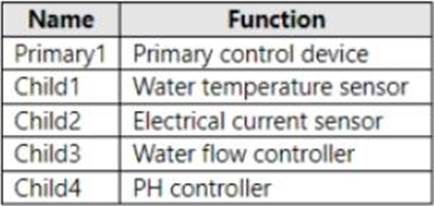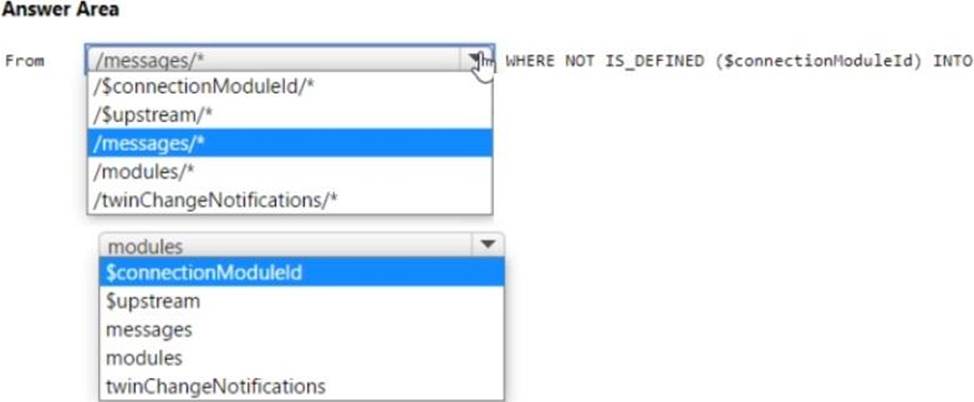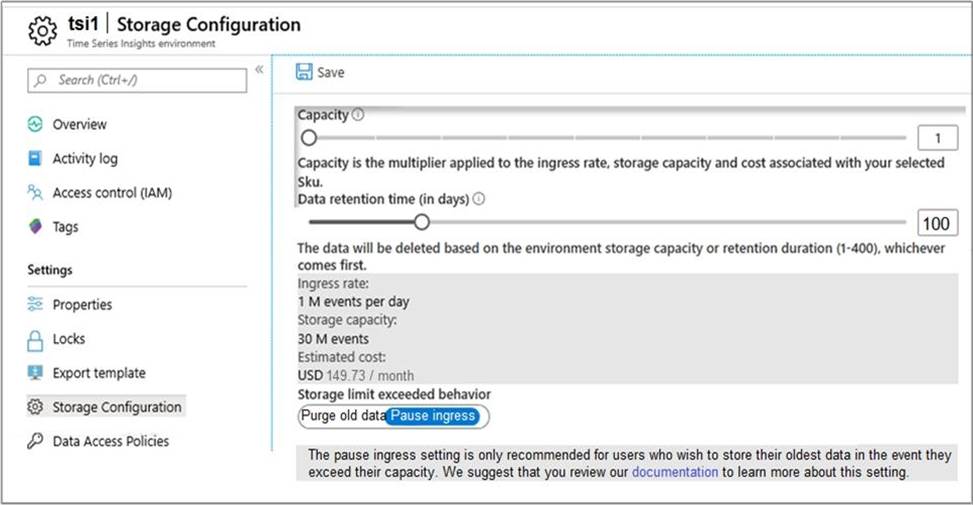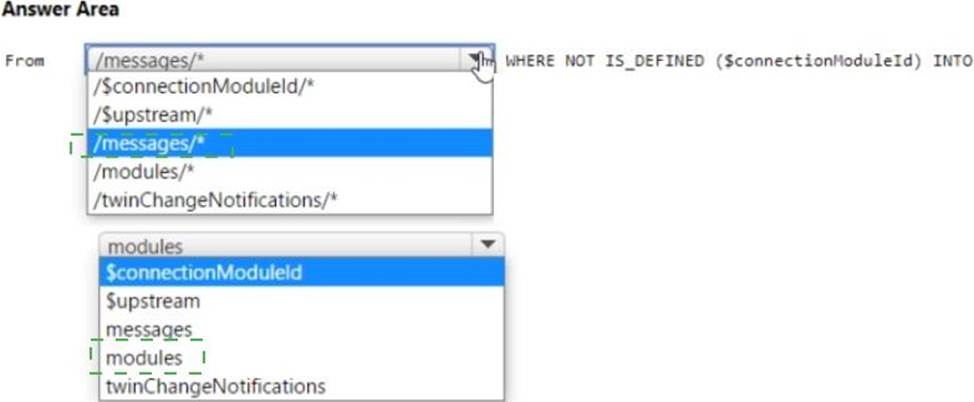Microsoft AZ-220 Microsoft Azure IoT Developer Online Training
Microsoft AZ-220 Online Training
The questions for AZ-220 were last updated at Dec 17,2025.
- Exam Code: AZ-220
- Exam Name: Microsoft Azure IoT Developer
- Certification Provider: Microsoft
- Latest update: Dec 17,2025
Topic 3, Fabrikam New
Case study
General overview
Fabrikam, Inc. is an international food company that has a main office in London and 250 sites worldwide.
FabRIkam uses a prototype hydroponics loT management system that tracks temperatures and PH levels and adjusts conditions automatically.
Location
The prototype environment is deployed to the main office.
IoT Hub
The management system uses a free tier Azure loT hub.
Devices
The prototype contains the devices shown in the following table.

Each device will use the following:
• A common set of Azure loT Edge modules
• A unique module for each type of sensor or controller
Each device has a device twin. Each device twin contains a tag that identifies the device type. For example, the device twin of Child4 contains a tag of ph. Each device sends 1.440 4-KB messages to the loT hub per day.
Pilot deployment
A pilot of the hydroponics loT management system will be deployed initially to 50 of the company’s worldwide sites.
Device Requirements
Fabrikam identifies the following device requirements:
• Cloud-to-device commands will be sent to each primary control device.
• All module communication from the child devices must be routed to the loT hub.
• The parameters of each device type must be configured in the loT Edge container configuration file.
• Device modules must be deployed to all the devices automatically, and then updated automatically. The solution must support targeted deployments by using device twin tags.
Networking Requirements
Fabrikam identifies the following networking requirements:
• Child devices will NOT have internet access.
• The primary control device in each site will have internet access.
• Child devices will communicate with their local primary control device by using the AMQP protocol.
Monitoring Requirements
Fabrikam identifies the following monitoring requirements:
• The number of device-to-cloud telemetry messages sent to the loT hub by the primary control devices must be tracked.
• An email notification must be sent if a message is NOT received from Child4 every 10 minutes.
Technical Requirements
Fabrikam identifies the following technical requirements:
• The solution must support cloud-to-device commands.
• Administrative effort must be minimized whenever possible.
• Hardware and software costs must be minimized whenever possible.
• Access to the loT hub must be restricted to devices that connect from the company’s sites.
You need to develop a messaging app that meets the technical requirements.
Which shared access policy should you use?
- A . service
- B . device
- C . lothubowner
- D . registryReadWrite
HOTSPOT
You need to configure loT module routing to meet the device requirements.
How should you complete the route? To answer, select the appropriate options in the answer area. NOTE: Each correct selection is worth one point.

You need to meet the monitoring requirements for device metrics.
What should you configure?
- A . Azure Time Series Insights
- B . Microsoft Power Bl
the Diagnostic settings - C . Azure Stream Analytics
You need to the configure the device parameters to meet the device requirements.
Which file should you update on each device?
- A . /etc/sensors3.conf
- B . /etc/host.conf
- C . /etc/aziot/edged/config.d
- D . /etc/aziot/config.toml
You need to configure device access to the loT What should you use?
- A . private endpoints
- B . IP Filter
- C . Azure Application Gateway
- D . network security groups (NSGs)
You need to design a module deployment strategy that meets the device requirements.
What should you create?
- A . a single deployment
- B . a standard deployment for each type of device
- C . a layered deployment for each type of device
- D . a single layered deployment
You need to configure a gateway for the child devices. The solution must meet the networking requirements.
Which gateway pattern should you use?
- A . transparent
- B . identity translation
- C . protocol translation
Topic 4, Misc. Questions
Note: This question is part of a series of questions that present the same scenario.
Each question in the series contains a unique solution that might meet the stated goals. Some question sets might have more than one correct solution, while others might not have a correct solution.
After you answer a question in this section, you will NOT be able to return to it. As a result, these questions will not appear in the review screen.
You have an Azure IoT solution that includes an Azure IoT hub, a Device Provisioning Service instance, and 1,000 connected IoT devices.
All the IoT devices are provisioned automatically by using one enrollment group.
You need to temporarily disable the IoT devices from connecting to the IoT hub.
Solution: You disconnect the Device Provisioning Service from the IoT hub.
Does this meet the goal?
- A . Yes
- B . No
DRAG DROP
You have an Azure IoT Edge device named Edge1.
You need to configure the module container to link the module storage to the host storage.
How should you configure the deployment manifest? To answer, drag the appropriate keys to the correct targets. Each key may be used once, more than once, or not at all. You may need to drag the split bar between panes or scroll to view content. NOTE: Each correct selection is worth one point.

HOTSPOT
You have an Azure IoT hub named Hub1 and an Azure Time Series Insights environment named tsi1. Tsi1 connects to Hub1. The solution has been operational for 6 months.
Tsi1 is configured as shown in the following exhibit.

Hub1 receives 1 million messages per day. Each message is up to 1 KB and is formatted as JSON.
Hub1 has seven days of retained telemetry.
For each of the following statements, select Yes if the statement is true. Otherwise, select No. NOTE: Each correct selection is worth one point.

Latest AZ-220 Dumps Valid Version with 88 Q&As
Latest And Valid Q&A | Instant Download | Once Fail, Full Refund




